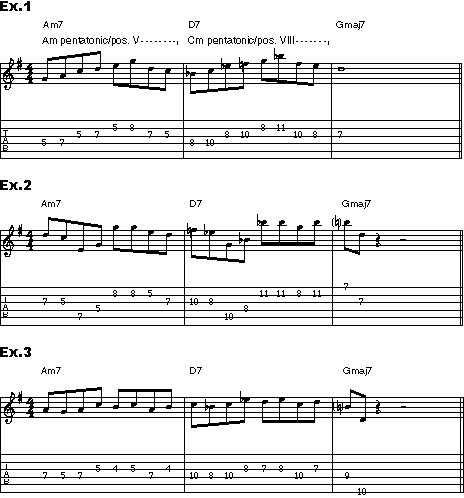In a IIm-V-I progression, the V is
typically the critical chord to
color with altered sounds. A V
provides tension that you
release by playing the I chord;
adding melodic tension to the V
makes this release even more
dramatic. Here's a simple
recipe for generating hip altered
notes over the V in a IIm-V-I
progression. Let's try it in G,
over Am7, D7 and Gmaj7.
Bar 1: Find the fifth-position A
minor pentatonic scale we all know and love, and use it to
craft a line over Am7 (the IIm) containing no more than eight eighth-notes.
Bar 2: Move up a minor third to the eighth-position C minor
pentatonic position and repeat the line over D7, the V.
Bar 3: Resolve the phrase by a half-step to a Gmaj7 chord
tone. (Visualizing Gmaj7 voicings at the 7th fret will help you
see the one-fret resolutions.)
Ex. 1 illustrates the "pentatonic-up-three-frets" IIm-V process.
First record the changes, and then play the line to hear the
tension and release. Moving bar 1's phrase up a minor third in
bar 2 automatically gives you three of D7's altered notes -- the
9 (E), 9 (E, here notated as F) and 5 (A or, as shown here, B).
In Ex. 2, notice how the last note of bar 2's transposed line
changes to accommodate the half-step resolution in bar 3.
Once you hear this V-I shift, you'll find it easily on the
fretboard. Again, for maximum payoff, play this over the chords.
When you've mastered the basics, you can loosen things up.
For example, you don't always have to resolve by a step
(although this sounds the smoothest), nor are you limited to a
minor pentatonic scale. Ex. 3 moves an A Dorian phrase up
the neck to C Dorian and then resolves to the I with a
major-third interval.
Use this finger-friendly technique to create uptown sounds
with minimum effort.
